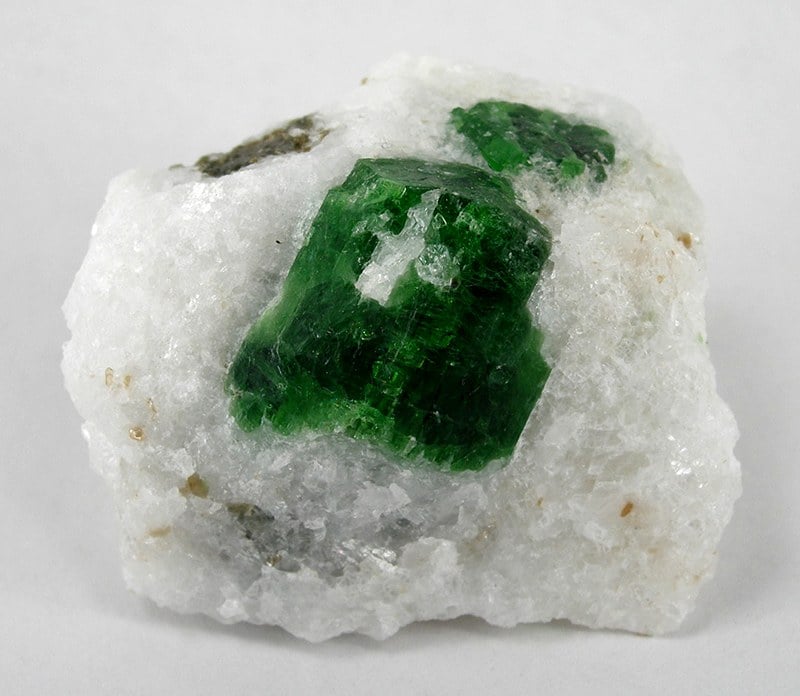Pargasite Value, Price, and Jewelry Information
The amphibole group is very large and extremely complex and contains numerous distinct species that vary subtly in chemistry and physical properties. Pargasite and ferropargasite are calcic amphiboles that generally are lumped together as hornblende,even though up to 16 distinct minerals belong to this group, including actinolite. The identity of a specific amphibole is determined (ideally) by a chemical analysis or by detailed measurements of density, color, and optical data. There are undoubtedly a great many localities that could potentially yield cuttable crystals.
The amphibole group is very large and extremely complex and contains numerous distinct species that vary subtly in chemistry and physical properties. Pargasite and ferropargasite are calcic amphiboles that generally are lumped together as hornblende,even though up to 16 distinct minerals belong to this group, including actinolite. The identity of a specific amphibole is determined (ideally) by a chemical analysis or by detailed measurements of density, color, and optical data. There are undoubtedly a great many localities that could potentially yield cuttable crystals.
Start an IGS Membership today
for full access to our price guide (updated monthly).Pargasite Value
See also: Actinolite; Hornblende; Amphibole; Series to Ferropargasite if Fe exceeds Mg.
Amphibole Group; closely related to Hornblende.
Optics:a=1.613; β= 1.618; γ=1.635.
Biaxial (+), 2V: 120°.
Occurrence: A widespread component of igneous and metamorphic rocks.
Pargas, Finland.
Scotland; Sweden; Russia; Austria; Venezuela.
Canada: Baffin Island, Nunavut; Nova Scotia.
United States:Fresno, California; Burlington, Pennsylvania.
Comments: The amphibole group is very large and extremely complex and contains numerous distinct species that vary subtly in chemistry and physical properties. Pargasite and ferropargasite are calcic amphiboles that generally are lumped together as hornblende, even though up to 16 distinct minerals belong to this group, including actinolite. The identity of a specific amphibole is determined (ideally) by a chemical analysis or by detailed measurements of density, color, and optical data. There are undoubtedly a great many localities that could potentially yield cuttable crystals.
Name: After the locality, Pargas, Finland.
Joel E. Arem, Ph.D., FGA
Dr. Joel E. Arem has more than 60 years of experience in the world of gems and minerals. After obtaining his Ph.D. in Mineralogy from Harvard University, he has published numerous books that are still among the most widely used references and guidebooks on crystals, gems and minerals in the world.
Co-founder and President of numerous organizations, Dr. Arem has enjoyed a lifelong career in mineralogy and gemology. He has been a Smithsonian scientist and Curator, a consultant to many well-known companies and institutions, and a prolific author and speaker. Although his main activities have been as a gem cutter and dealer, his focus has always been education. joelarem.com
Related Articles
Black Diamond Value, Price, and Jewelry Information
Chameleon Diamond Value, Price, and Jewelry Information
Gray Diamond Value, Price, and Jewelry Information
Green Diamond Value, Price, and Jewelry Information
Latest Articles
Pearl Simulants: How to Spot Faux Pearls
Opal Buying Guide
Amethyst Sources Around the World: The Geological Story Behind These Purple Gemstones
Brazilianite Value, Price, and Jewelry Information
Never Stop Learning
When you join the IGS community, you get trusted diamond & gemstone information when you need it.
Get Gemology Insights
Get started with the International Gem Society’s free guide to gemstone identification. Join our weekly newsletter & get a free copy of the Gem ID Checklist!
